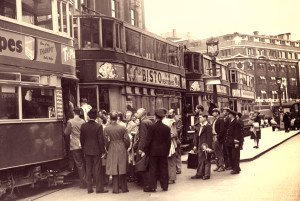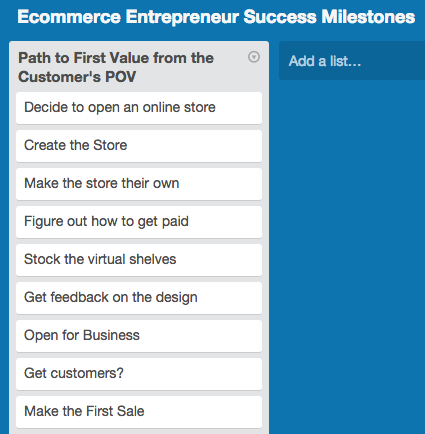![]() Também disponível em Português por Mathias Luz
Também disponível em Português por Mathias Luz
 Customer onboarding has come up a lot lately, which is great since having a poor onboarding experience for your customers can pretty much kill your growth… if not your business.
Customer onboarding has come up a lot lately, which is great since having a poor onboarding experience for your customers can pretty much kill your growth… if not your business.
The first in-app experience your customer has with your product sets the tone for your relationship, and if it’s confusing, overwhelming, or otherwise puts up barriers to achieving success (or at least recognizing the value potential in your product), you’re in trouble.
As I say all the time, the seeds of churn are planted early, and those seeds are planted deep if your onboarding experience for new customers or your prospects during a free trial is terrible.
Every time I talk to a low-touch, self-service SaaS company experiencing massive drop-off immediately after sign-up, low Free Trial-to-Paid conversion rates, few customers staying past 90 days post-conversion, etc. it is always an onboarding issue.
When I talk to Enterprise, high-touch SaaS companies that experience a lot of churn or non-renewals, aside from misleading sales practices, the main culprit is the customer onboarding process. Whether the Time to First Value is too long, the experience is painful, or expectations are simply mismanaged, those “seeds of churn” can be traced back to onboarding.
Proper onboarding isn't done to prevent churn; it's done to ensure the customer achieves their Desired Outcome. Retention comes from that.
— Lincoln Murphy (@lincolnmurphy) April 21, 2016
Regardless of whether it’s a high-touch or low-touch scenario, 100% of the time, the problem is that the SaaS vendor either doesn’t know what the customer or prospect’s Desired Outcome is… or forgot that solving for that is the most important thing.
What defines an ‘Onboarded’ Customer?
Most people think in terms of “functional” or technical onboarding; getting their customers and users to go through the motions to get “up-and-running” with their product rather than equating onboarding with a value delivery milestone.
But even if they focused on value delivery, there’s still no universal definition of a fully-onboarded customer; it’s simply different for every company.
And for SaaS vendors – where customers can start small and (ideally) expand their use of the product over time – the notion of “onboarded” as a status is even harder to nail down than it was with traditional Enterprise software.
So, since it’s hard to nail it down and there’s no universal definition for it, I prefer to consider a customer “onboarded” as one of two poential states:
- they’ve achieved “initial success” with your product (consider this First Value Delivered – FVD)
- they haven’t gotten actual value yet, but for the first time outside of your sales and marketing, they see the real value potential in this relationship with you.
So, what “initial success” (realized or potential) does my customer need to achieve when all parties understand that the breadth and depth of use will continue to evolve and expand over their lifetime as a customer? That’s a great question to keep top of mind as you go through this process.
When I talk to someone about optimizing their SaaS Free Trial for more conversions, as an example, I ask them what a successful Free Trial looks like for their prospect. And no… it’s not “they convert to a paying customer.”
That’s YOUR definition of success; don’t confuse that with THEIR definition of success.
Situational Success: Trial, Proof of Concept, and Early Lifecycle
While we’re solving for their initial success – not ours – you’ll find in a Free Trial, for example, that initial success for your customer is actually the point where becoming a paying customer is the next most logical step. So you’ll get that “they convert to a paying customer” outcome you want, by focusing on the outcome they want. Winner-Winner.
They’ve realized value – or they’ve seen the value potential in the product – and they’re technically ready to convert.
That could happen on day 2 of a 30-day free trial, but most companies will let them go the full 30-days (or even longer) before they try to get them to convert.
Imagine if you asked for the sale right after they achieved “success” … if that happens on day 3, you could convert a customer on day 3 of a 30 day trial, instead of waiting until the trial is over.
This is also why you should tie your customer or prospect communication (in-app messages, emails, phone calls, etc.) to their progress – or lack thereof – through those success milestones instead of saying you’ll just send something on Day 1, 5, 7, and 32.
Since your customers will achieve success on their own cadence, having a timed autoresponder sequence – when the technology is readily available to trigger based on milestones reached – is just irresponsible.
Okay, that makes sense… but how do you create a plan, customer journey map, etc. that will guide the customer to achieve “success” in the first place?
You create a plan to get here by identifying “initial success” and backing out from that goal while identifying success milestones along the way.
Not Sure How they Define Success? Ask.
Whenever I layout that plan for creating the success milestones, though, I always get people saying they don’t even know what success looks like for their customers in the first place. How do you figure that out?
That was a great question to ask BEFORE you built your product, probably… but at least you’re asking it.
The easiest way to figure out what success looks like for your customer – before you can break that down into milestones – is to ask them.
- What is their Desired Outcome? (Don’t ask them this directly, but ask questions that expose this)
- How do they measure success themselves?
- How are they measured by their boss?
- What are they trying to achieve with your product?
I’d ask them what “success” means to them first, do that with several from a similar cohort (if you have multiple types of customers across various use cases – as you often find in very horizontal products – you may want to pick an ideal customer to focus on initially), analyze that for similarities and patterns, reduce it down to a handful of absolute required outcomes, and then turn it back to them for approval/buy-in.
But to be absolutely clear, you’re getting them to tell you the outcomes they desire, and maybe the milestones needed to get to that “success” with your product.
You’re not asking them what they need or want (features, functionality, or even workflows) since they’ll just tell you what they’ve done before or what they wish they could have done; if you build end up simply being iterations on existing ways of doing things.
You can make big leaps forward by understanding not what they need to “do” but what they need/want to achieve and using your creativity/engineering prowess/entrepreneurial spirit to solve for that. This is where Desired Outcome thinking really shines, BTW.
Iterating on existing processes isn’t fun or really the lucrative in the long run.
A Thought Experiment: The Online Store Builder
Let’s say you have an e-commerce store builder, what does initial success look like for your customer?
The first time they sell an item? Sure… we’ll go with that.
What are the things the need to do to achieve success?
Customer-Centric Success Milestones:
- Decide to open an online store <== the required step 0
- Create the Store
- Make the store their own
- Figure out how to get paid
- Stock the virtual shelves
- Get feedback on the design
- Open for Business
- Get customers? (Potential Success Gap here, BTW)
- Make their First Sale! <== success (at least at first)
To the right is what it would look like if mapped out in Trello (you can get access to the actual Trello board here).
What might that look like in the product?
- Sign-up for the Trial <== the required step 0
- Create the Store
- Customize the Store <== The “Wow!” moment is here maybe
- Setup Payment Method <== gotta get paid!
- Add & Configure Items
- Soft-launch Store w/ Friends and Family
- Incorporate Feedback and Refactor
- Publish Store and Promote
- Their First Sale! <== this is actual success, right?
Below is what it would look like if mapped out in Trello (you can get access to the this Trello board here):
Whether that’s the right set of success milestones for an e-commerce store builder isn’t the point, but I got there by saying “what would success look like for my customer?” and backing out from there to meet them where they are at first.
Like I said earlier, don’t guess about what “success” is for your customers. If you don’t know, ask them.
In the early days, this is where Customer Development work really pays off. But, if you’re in-market and looking to optimize, this is where leveraging the expertise, experience, and knowledge of your Customer Success Management software (or your Customer Success Managers) and/or continually doing new Customer Development really comes into play.
Just Focus on the Next Success Milestone
The cool part of breaking down the onboarding process like this is that while you must keep the overall goal of success in mind, you only have to solve for the next success milestone with your lifecycle messaging, app design, etc.
Once they reach that milestone, onto the next one and so on. This makes creating those email or in-app lifecycle messages easier and results in them being much more effective.
Oh, and keeping this “success milestone” way of thinking after they become a customer – or are otherwise past the customer onboarding process – will allow you to surface upsell/cross-sell offers, as well as advocacy requests, at the perfect time so you’re more likely to get a positive result.
BTW, this way of onboarding customers is exactly how I helped one SaaS company take their average conversion time on a 30-day Free Trial from 42 days (yes, an average of 12 days post-expiration for conversion to paying customers) to… 3 days. Yes, you read that right. Average conversion time went fro 42 days to just 3 days.






